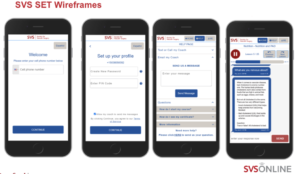
Call it timing on several fronts, each part coming together for the benefit of patients with peripheral arterial disease (PAD).
Included in the mix was an interest on the part of the Society for Vascular Surgery (SVS) to utilize technology to improve patient health and outcomes. Also percolating was an idea for an app to incentivize and monitor exercise therapy with the goal of delaying or preventing the need for intervention. And then there was the desire to be able to detect failing interventions in time to re-intervene for better outcomes.
It’s all led down a long and winding road to the SVS Supervised Exercise Therapy (SET) app, announced last year and now in pilot testing. The hope is that by the Vascular Annual Meeting (VAM) in August, SVS SET will be more widely available for SVS members and other physicians to prescribe.
The app is geared to help PAD patients manage their disease at home through supervised exercise—considered the gold standard in the initial and longitudinal management of PAD—plus coaching and education. SVS is spearheading the app and therapy in partnership with Cell-Ed, a remote learning and telehealth company. After more than a year in development the therapy is now in pilot testing at 13 sites across the country. Physicians prescribe the therapy and patients complete it from their home using their mobile phones. Cell-Ed provides live health and wellness coaching, and education on behavioral risk factors such as smoking.
The program calls for walks five days a week (with a minimum of three) for up to 60 minutes for 12 weeks. The app works on any mobile device, even “no-feature” phones.
SET app genesis
Approximately two years ago, SVS leadership figures were discussing ways to better communicate and solidify the longitudinal and comprehensive approach vascular surgeons take in caring for patients with vascular disease—the journey of managing vascular disease often starts with medical management prior to any surgical interventions.
Led by Kim Hodgson, MD, then SVS president, the leaders also wanted to work on initiatives that would use technology to help surgeons in new ways. Why not work on developing an app to monitor PAD patients as part of walking therapy? “We don’t just do interventions,” said Hodgson. “We provide comprehensive care.”
And so, SVS leadership put out a call for volunteers for a new Health Information Technology Task Force, whose initial focus would be on the development of the SET app. The interest and expertise of SVS members in this arena was significant, said Hodgson. Judith Lin, MD, professor and chief of vascular surgery at Michigan State University College of Human Medicine was selected to chair the new task force.
Another volunteer was Oliver Aalami, MD, a clinical associate professor of surgery and the director of Biodesign for Digital Health at Stanford University. He had already been working on the technological aspects of monitoring movement using personal digital technology.
His own frustration with failed interventions was behind his interest. Patients who came in with occluded stents had noted three months earlier that they couldn’t walk as far as previously but thought the situation would improve. A lightbulb went off. “That is where this journey started,” Aalami said. “Scar formation and neointimal hyperplasia are the most frequent causes of stent failure and subsequent difficulty walking, and this forms slowly over time. I wondered, can we detect patterns of decline in activity and correlate this with early stent failure? This could help personalize surveillance protocols.”
SVS leaders approached Aalami because of his digital health research and suggested a home-based exercise therapy program to bolster the utilization for patients with symptomatic PAD. Months of development followed, led by the HIT Task Force in concert with Cell-Ed.
The need for supervised therapy is there. Surveys show that though 49% of providers said they have referred patients for SET, a whopping 98% said they would if they could.
Cost and inconvenience hinder prevalence. Reimbursement requires a hospital-attached setting where providers are on-site, but land and facility costs put that out of reach for many. Moreover, reimbursement typically covers the facility fee but not the supervision fee.
Aalami began his work from a technical standpoint. Because typical PAD patients are older and have financial restraints, accessibility was key. A functional program of value “had to be deliverable on the most basic of phones,” he said. Patients who do have smartphones, on the other hand, “get all the bells and whistles,” including steps walked every day, plus activity trends that are predictive of functional capacity.
At the same time, Cell-Ed provides the app’s live coaches patients need for encouragement and support in order to change their behavior, as well as the education and information to learn more about the disease. The HIT Task Force designed and is conducting the pilot study of the app, which thus far seems to be a success, said Task Force chair Lin. Coaches report significant patient enthusiasm and progress.
Obstacles
A major obstacle to widespread program adoption is reimbursement. While the SVS has funding for the pilot program and an upcoming randomized controlled trial, there is much uncertainty as to what happens down the road.
“It can’t be a free program forever,” said Aalami. “We hope that if payors find out it’s working, they’ll pay to incentivize their members to do it.” One possibility is the telemedicine model, which could create reimbursement avenues for providers. “The earliest opportunities for adoption lie within value-based healthcare systems or with providers who participate in alternative payment models such as Medicare Advantage,” said Aalami.
Currently, supervised exercise therapy must be done in person or it’s not reimbursed, explained Sunita Srivastava, MD, assistant professor of surgery at Harvard Medical School and chair of the SVS Coding and Reimbursement Committee. “The SVS SET app and Cell-Ed coaching are really supervising but using mobile technology to do so.” With this in mind, the SVS is exploring and expects to be advocating for more reimbursement of remotely supervised exercise therapy. One example of such therapy being successful is in The Netherlands, where any patient who wants even to consider intervention for PAD must first complete a SET program. “In five years, 83% of patients didn’t need intervention,” said Aalami.
Can it work for the app? By the end of June, SVS leaders hope to see if the program has significantly affected passive activity, quality-of-life scores, the six-minute walk test and, most importantly, the goals patients set for themselves. A longer-term goal is to evaluate if a remote program can delay or prevent intervention.
Enrollment
The randomized controlled trial will start by May. Sites are currently being recruited, including those with and without in-person exercise therapy programs. Organizers want to see how in-person programs affect the therapy, and if in-person and remote programs both meet patients’ goals. In parallel with the randomized controlled trial, other sites will be able to enroll and offer the program to their PAD patients.
Aalami said he believes the SET app merely scratches the surface in terms of technology and remote monitoring, data-driven results and the future. The Vascular Quality Initiative is exploring the possibilities because of the new importance on patient-centered and patient-reported outcomes. “It all started for me with more personalized monitoring after stent placement—is there a correlation between disease burden and activity?” he said.
Hodgson agreed. “It’s still a work in progress; we’re still seeing where this can go. I think it can go a lot further.”
And it all starts with walking.
SEE ALSO:












